Holidays in Garda on Lake Garda
Garda is a stunning vacation destination on the eastern shore of Lake Garda, offering a perfect blend of history, nature, and Mediterranean charm. Whether you are looking for a beach holiday, an active getaway, or a cultural trip, Garda has something for everyone. The town is nestled in a protected location between the two mountain ridges of Monte Luppia in the north and the plateau in the south.
A gem on the eastern shore of the lake
Where is Garda located?
The town of Garda is situated on the eastern shore of Lake Garda in the Veneto region of Italy. It lies approximately 30 km northwest of Verona and is easily accessible via the A22 motorway. Garda is an important tourist hub, as many hiking and cycling routes converge here. Additionally, the town is well connected to the Gardesana Orientale (SS249) road, which links the eastern towns of the lake.
History of the town
The name “Garda” originates from the Germanic word "Warda", meaning "watch" or "viewpoint" – a reference to the town's strategic location. During the Middle Ages, Garda was a significant fortress, the remains of which can still be seen on Rocca di Garda today. The historic old town, with its narrow alleys and ancient buildings, serves as a reminder of its rich past.
Attractions & activities
The most beautiful places in Garda
- The old town of Garda: A walk through the charming narrow streets, lined with small boutiques, cafés, and gelaterias, reveals a mix of Venetian and Lombard architecture.
- The promenade "Lungolago Regina Adelaide": One of the most picturesque promenades on Lake Garda, stretching for several kilometres along the shoreline.
- The church of Santa Maria Maggiore: A Gothic church from the 15th century, featuring impressive frescoes and a special statue of the Virgin Mary.
- Palazzo dei Capitani & Palazzo Losa: Built in the 15th and 16th centuries, these palaces reflect the influence of Venetian merchants in Garda.
- Villa Albertini: This magnificent building with towers and battlements is tucked away behind a wall at the northern end of the old town. It was briefly the residence of King Carlo Alberto of Piedmont.
The best beaches
- Spiaggia Baia delle Sirene
- Spiaggia La Cavalla
- Spiaggia Punta San Vigilio
Hiking & nature experiences around Garda
Several hiking trails lead from Garda into the surrounding hills and forests. One of the most popular routes is the climb to Rocca di Garda, offering a spectacular panoramic view over Lake Garda. The distinctive plateau rising 250 meters south of Garda is accessible via a one-hour hike, which starts to the left of Santa Maria Maggiore Church.
Another great route leads to Monte Luppia, passing through olive groves and forests until reaching the impressive rock formation "Sasso della Stria". For those who love scenic hikes, the Sentiero del Pellegrino is a stunning coastal trail that leads from Garda to Torri del Benaco.
Practical travel tips
Getting to Garda – Car, bus, train, and plane
- By car: Take the A22 Brenner Motorway, exit at Affi, and continue approximately 10 km to Garda.
- By train: The nearest train station is in Peschiera del Garda (about 17 km away), with regular bus connections to Garda.
- By plane: The Verona Airport (about 35 km away) is the best option for air travellers.
Best time to visit Garda – Weather & climate
The best time to visit Garda is from April to October, when the weather is warm and sunny.
-
 The northern Italian municipality of Garda has over 4,000 inhabitants and is located in the province of Verona, directly on Lake Garda.
The northern Italian municipality of Garda has over 4,000 inhabitants and is located in the province of Verona, directly on Lake Garda.
-
 Top view of the shore of Lake Garda near Garda
Top view of the shore of Lake Garda near Garda
-
 Lake promenade in Garda
Lake promenade in Garda
-
 Lake promenade, with viewing pavilion, restaurants and bars
Lake promenade, with viewing pavilion, restaurants and bars
-
 Small headland on the eastern shore of Lake Garda, between Garda and Torri del Benaco
Small headland on the eastern shore of Lake Garda, between Garda and Torri del Benaco
-
 From Garda, Lake Garda fans can take boat trips to Torri del Benaco, Salò, Sirmione and Bardolino.
From Garda, Lake Garda fans can take boat trips to Torri del Benaco, Salò, Sirmione and Bardolino.
-
 Town hall and community centre
Town hall and community centre
-
 Rest during the cycle tour with a view of Punta San Vigilio
Rest during the cycle tour with a view of Punta San Vigilio
-
 Colourful boats in the harbour of Garda
Colourful boats in the harbour of Garda
-
 View of the Rocca di Garda viewpoint
View of the Rocca di Garda viewpoint
-
 Romantically decorated tower on historic estate in Garda
Romantically decorated tower on historic estate in Garda
-
 Picturesque centre of Garda
Picturesque centre of Garda
-
 The city harbour and the Palazzo Capitani attract numerous visitors at the Lake Garda.
The city harbour and the Palazzo Capitani attract numerous visitors at the Lake Garda.
-
 From the waterfront promenade Reghina Adelaide, you have a wunderful view over the table mount Rocca di Garda.
From the waterfront promenade Reghina Adelaide, you have a wunderful view over the table mount Rocca di Garda.

